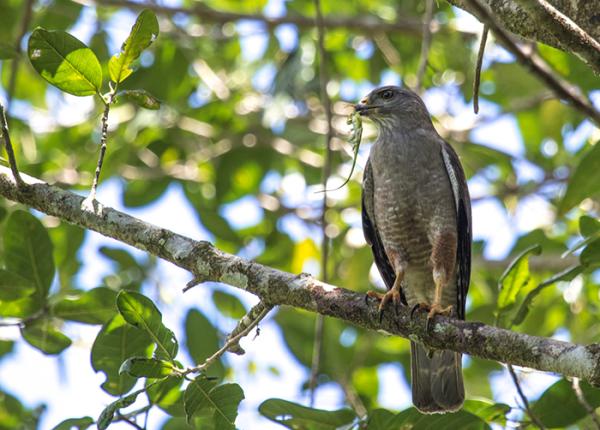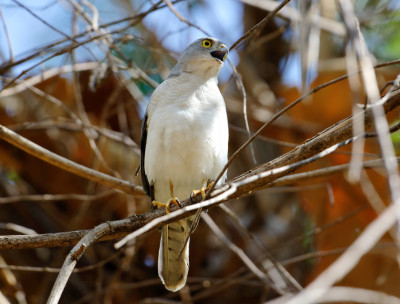Did you know?
- The Ridgway's Hawk was once considered one of the most Critically Endangered raptors in the world, but our work with the species brought it back from the brink of extinction.
- This hawk often builds its nest right on top of an active nest of Palmchats, the national bird of the Dominican Republic. The hawks add larger twigs on top of the existing Palmchat nest, without causing any harm to the smaller birds nesting below. It's like a two-story building for birds!
- The Ridgway's Hawk was rediscovered in Haiti in August 2019 after not being documented there since 1962!
How The Peregrine Fund is helping
When The Peregrine Fund first encountered the Ridgway's Hawk in 2002, we discovered that local communities viewed these hawks as chicken predators, leading to shooting and capturing that decimated their numbers. Fewer than 300 individuals remained, and the species was classified as Critically Endangered.
When we initiated our recovery efforts, Ridgway’s Hawks were found only in Los Haitises National Park in the northeast Dominican Republic (DR), so we started there. But with the entire species compressed into one population, a single threat such as a hurricane or disease outbreak could have had disastrous effects. To alleviate this risk, we began searching for new locations to establish additional populations. We finally settled on Punta Cana, in the east, an area where the last Ridgway's Hawk sighting had occurred in the late 1900s. At Punta Cana, between 2009 and 2017, a total of 127 young hawks were released. As of 2023, there were a total of 28 pairs in Punta Cana and second and third-generation hawks producing young, with over 130 wild fledglings documented. With two successful populations in Los Haitises and Punta Cana, we expanded the reintroduction of Ridgway’s Hawks to Aniana Vargas National Park in central DR in 2019. We also work with partners in Les Cayemites, Haiti to grow a newly-discovered small population.
To address community attitudes towards the hawks, our team launched an environmental education program that reaches into classrooms, community centers, and households across the region. Through immersive presentations, engaging classroom activities, empowering teacher workshops, colorful brochures, and personal door-to-door conversations, our environmental education programs have sparked a remarkable transformation in community attitudes. Annual Ridgway's Hawk Day celebrations—May 25 in the Dominican Republic and August 19 in Haiti—stand as a joyful testament to this shifting perspective. Where hawks were once feared, they are now revered and elevated with community pride for this unique species.
Learn more about our Ridgway's Hawk Recovery Program.
Where they live
The Ridgway's Hawk lives on the island of Hispaniola, which is shared by the nations of Haiti and the Dominican Republic (DR), and a few outlying islands in the Caribbean Sea. This means that the Ridgway's Hawk is found only in this small region and nowhere else in the world. When The Peregrine Fund began working to conserve the Ridgway's Hawk in 2002, they were found only in Los Haitises National Park. Reintroduction and management efforts have expanded that to three distinct locations in the DR: Los Haitises National Park in the northeast, Punta Cana in the east, and Aniana Vargas National Park in central DR.
In August 2019, two Ridgway's Hawks were rediscovered on Les Cayemites, a small set of satellite islands located off the coast of southwest Haiti. Prior to that observation, the Ridgway's Hawk was last documented in Haiti in 1962! Since its rediscovery, annual breeding season surveys have documented additional individuals on Les Cayemites, including at least eight breeding pairs.
Although this species appears to prefer undisturbed forest in lowlands and foothills, it lives in a wide variety of habitats, including rainforests, subtropical dry and moist forests, pine forests, limestone karst forests, and woodlands. It is even found in human-altered habitats, including plantations, degraded forest fragments, and pasture lands. This ability to adapt and survive in different types of environments is good news for the species! As long as adequate prey and nesting sites exist, the Ridgway's Hawk has a good chance of surviving even in areas that have been dramatically changed by people or by other factors.
What they do
This medium-sized hawk has broad wings and a relatively long tail, allowing it to maneuver deftly through thick forest. However, it also spends a lot of time in open areas, sometimes perching low to the ground as it scans for prey. The Ridgway's Hawk also likes to soar and can be seen flying among Turkey Vultures or all by itself high in the sky.
Unlike many raptor species that are sensitive to human activity, the Ridgway's Hawk is not shy around people and sometimes can be found nesting in small patches of land very close to settlements and roads. If people get too close to its nest, however, this hawk is quick to defend its territory against them or any other potential predator. It vocalizes loudly or flies swiftly after the perceived threat, stooping and chasing it to a safe distance away from the nest and young. Often, both the male and female work together to chase off intruders.
Apart from their alarm call, which is a high-pitched wail, Ridgway's Hawks have a wide array of calls. They are a vocal species and this makes it relatively easy for biologists to locate them in the forest.
Why they need our help
Since the late 19th century, the Ridgway's Hawk population has been in steep decline. Much of their native habitat is disappearing through clear-cutting of forests and wildfires, and many individuals are being shot or taken from the nests by people who eat them or kill them for fear that these beautiful hawks will prey on their chickens. In addition to these two main threats, other factors could be affecting the hawks' ability to survive.
Peregrine Fund biologists working with this species have found that the nestlings are often infested with botfly larvae, blood and tissue-eating parasites that can kill the young birds if they are not treated. Our team now treats nests with an insecticide, which has increased productivity by threefold compared to untreated nests.
Historically, Ridgway's Hawks nest in hardwood and palm trees. Today, with fewer and fewer hardwood trees still standing, the hawks are nesting almost entirely in palm trees. While these are great nesting sites, they do present a problem. The palm fronds naturally peel off and are shed throughout the year. If the palm fronds supporting the nest fall away while there are still eggs or very small nestlings inside, this could mean trouble. If the eggs or young fall to the ground, there is very little chance they will survive.
Because the population of Ridgway's Hawks is small and isolated, this species is at a greater risk for extinction. If a hurricane or disease were to sweep through the area, the entire population could be wiped out at once. If such an event were to occur, the species would be lost forever.
What they eat
Ridgway's Hawks are not picky eaters. Unlike the Snail Kite, whose diet consists almost entirely of apple snails, the Ridgway's Hawk eats just about anything small enough to catch. They feed on snakes, such as the green vine snake, as well as lizards and skinks, frogs and toads, small rodents, bats, and birds. In one study of 20 nesting pairs, biologists documented that reptiles comprised 97% of the prey items. That's a lot of snakes and lizards!
Ridgway's Hawks are patient hunters. Unlike some other raptors who fly high in the sky in search for food, these hawks spend a lot of time perched in relatively low snags or branches. When prey is spotted, they dive after it, often snatching it up from a log or directly from the ground. During nesting season, and perhaps all year-round, these hawks sometimes cache, or store, food to be eaten later. This saves them time and energy and allows them to take advantage of an easy catch, instead of letting it escape because they aren't hungry at the moment. It is like a person buying enough groceries for several meals, rather than going to the store every time hunger strikes.
Nest, eggs and young
Like many other raptors, the male Ridgway's Hawk often brings prey to the female during courtship. This helps create or strengthen the bond between them, an important factor for a successful nesting season. Though the male often consumes part of the catch before bringing it to the female, sometimes he will allow her to eat first and then finish off her leftovers. On one occasion, biologists observed a male flying into his territory with a thin, black snake in his talons. He placed it in a tangle of vines at the female's feet. At that point, both the male and female began feeding on the snake, one bird at each end—almost like the dogs eating spaghetti in the movie "Lady and the Tramp"!
During nesting season, the male does most of the work building the nest. He carries branches and twigs in his talons or beak and carefully arranges them into a platform of sticks. His efforts help to create a safe, comfortable place for the female and the nestlings. These hawks usually build their nests high up in hardwood trees or palm trees, such as the royal palm. In fact, royal palms are very popular nesting sites for other endemic bird species. The Palmchat, the national bird of the Dominican Republic, builds its nest among the palm fronds. Then the Ridgway’s Hawk comes along and builds its nest right on top of the Palmchat nest. These palm trees also often have excavated holes containing the nests of the Hispaniolan Woodpecker. In 2012, one royal palm contained a Ridgway’s Hawk nest, a Palmchat nest, a Hispaniolan Woodpecker nest, and bats roosting inside the hollow trunk. Talk about a popular place!
When breeding season is in full swing, the female lays one to three eggs (usually two) that are cream-colored and mottled with orange-red spots. Now it is the female's turn to work hard. She does most of the incubating, which requires long hours of sitting and occasionally turning the eggs. When she leaves the nest to feed or stretch, the male might briefly take over the incubation duties. The eggs are incubated for about 35 days before the young hatch.
While the female is incubating and after their young hatch, the male is responsible for catching enough food to feed himself, the female, and their young. When he arrives with prey, he often vocalizes loudly, signaling to the female that it is time to eat. The female shares the catch with the young, tearing off small pieces of meat and delicately feeding them to her nestlings. The Ridgway's Hawks nestlings grow fast, and in 40-50 days they are ready to fledge, or fly for the first time. The young hawks remain in their parents' territory for about three months before flying off and looking for a territory of their own.










